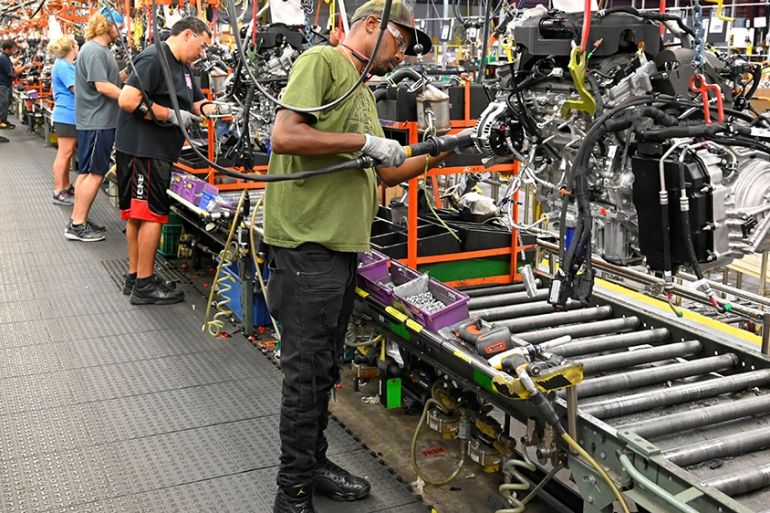US manufacturing contracts for first time in three years
The rate of production growth was among the slowest seen in over three years.

Manufacturing activity in the United States contracted for the first time in three years in August, with new orders and hiring declining sharply as trade tensions weighed on business confidence, raising financial market fears of a recession.
“Deteriorating exports are the key to the downturn, with new orders from foreign markets dropping at the fastest rate since 2009,” said Chris Williamson, chief business economist with financial information firm IHS Markit. “Hiring has stalled as companies worry about the outlook.”
Keep reading
list of 4 itemsRussia’s Putin eyes greater support from China for Ukraine war effort
India-Iran port deal: A gateway to Central Asia or a geostrategic headache?
India’s income inequality widens, should wealth be redistributed?
Concerns about the US economy, which is in its longest expansion ever on record, were further exacerbated by data released by the Department of Commerce on Tuesday showing construction spending barely rising in July.
The reports somewhat offset last week’s upbeat figures on consumer spending which suggest that though US economic growth is slowing, it is not losing momentum as rapidly as financial markets were flagging.
The economy’s waning fortunes have been blamed on the White House‘s year-long trade war with China. President Donald Trump said on Tuesday that trade talks with China were going well, but he warned that he would be “tougher” in negotiations if the discussions drag on past the 2020 US election and he wins a second term.
“The canary in the mine may be falling off its perch,” said Joel Naroff, chief economist at Naroff Economic Advisors in Holland, Pennsylvania. “With manufacturing now starting to contract, it is even more critical that the consumer keeps spending.”
The Institute for Supply Management (ISM) said its index of national factory activity dropped to a reading of 49.1 last month from 51.2 in July. A reading below 50 indicates a contraction in the manufacturing sector, which accounts for about 12 percent of the US economy. Last month marked the first time since August 2016 that the index broke below the 50 threshold.
August’s reading was also the lowest since January 2016 and was the fifth straight monthly decline in the index. The US now joins the eurozone, Japan, the UK, and China, which have long been experiencing a contraction in factory activity.
Still, the ISM index remains above the 43 level, which economists associate with a recession. The US-China trade tensions also coincide with diminishing stimulus from last year’s $1.5 trillion tax-cut package.
The ISM said there had been “a notable decrease in business confidence,” adding that “trade remains the most significant issue, indicated by the strong contraction in new export orders.” Economists polled by Reuters had forecast the ISM index would slip to 51.0 in August.
The US-China trade fight is eroding business sentiment, with business investment contracting in the second quarter for the first time in more than three years. That, together with an inventory bloat, is undercutting manufacturing, with output declining for two straight quarters.
Consumers have largely shrugged off the trade dispute and continued to spend, propping up the economy. But that could change with the trade war spilling over to shopping malls.
A new round of US tariffs on imports of Chinese goods, mostly consumer products like clothing, footwear and televisions, took effect on September 1. Additional US tariffs are due to be imposed in December.
With trade tensions simmering in the background, the US central bank, the Federal Reserve, is expected to cut interest rates again this month to keep the economic expansion, now in its 11th year, on track.
The Fed lowered its short-term interest rate by a quarter percentage point in July for the first time since 2008, citing trade tensions and slowing global growth. Financial markets have fully priced in another quarter-percentage-point cut at the Fed’s scheduled September 17-18 policy meeting.
US Treasury prices rose on the factory data, with the yield on the benchmark 10-year note dropping to its lowest since July 2016. The Treasury yield curve has inverted, signalling that a recession is looming. Stocks on Wall Street fell, while the dollar was little changed against a basket of currencies.
Orders tumble
The ISM’s forward-looking new orders sub-index dropped to a reading of 47.2 last month, the lowest level since June 2012, from 50.8 in July. A measure of export orders plunged 4.8 points to the lowest level since April 2009.
The survey’s factory employment tumbled to 47.4, the weakest reading since March 2016, from 51.7 in July. This raises the risk that factory payrolls contracted in August. Manufacturers cut hours in July, pushing the factory workweek to its lowest level since November 2011. Factories also cut overtime in July.
The government will publish August’s employment report on Friday.
“This (ISM) report is a warning that the tariff and trade uncertainty is continuing to weigh on manufacturing activity, and that this uncertainty is a growing risk to the expansion,” said John Ryding, chief economist at RDQ Economics in New York.
The ISM said nine industries, including furniture and related products, machinery and chemical products reported growth last month. Transportation equipment, primary metals, and electrical equipment, appliances and components were among the seven industries reporting a contraction.
Machinery manufacturers said, “business is starting to show signs of a broad slowdown.” Electrical equipment, appliances and components makers complained that “tariffs continue to be a strain on the supply chain and the economy overall.”
That sentiment resonated across all industries. Manufacturers of furniture and related products said: “incoming sales seem to be slowing down, and this is usually our busiest season.”
“The story up until now has been global manufacturing recession, with the US standing out as the strongest among the weakening players,” said Chris Low, chief economist at FTN Financial in New York. “The White House could help enormously by delaying further escalation of the trade conflict.”